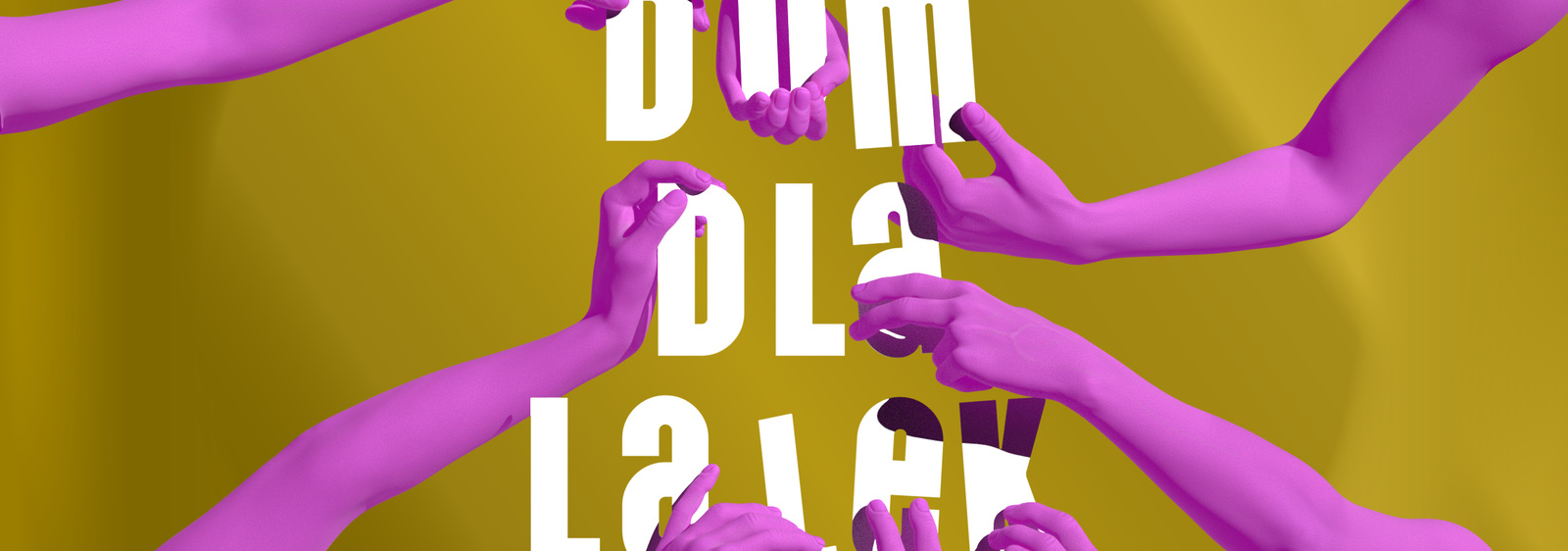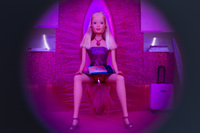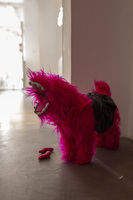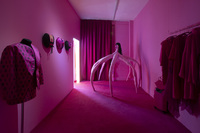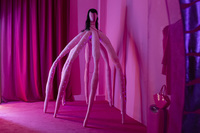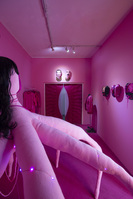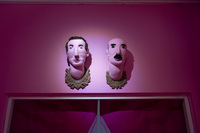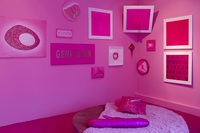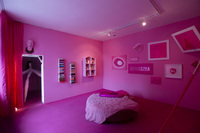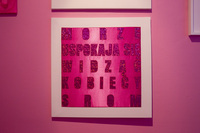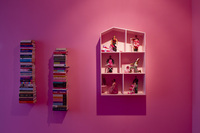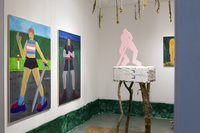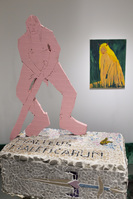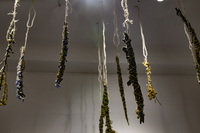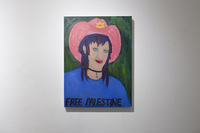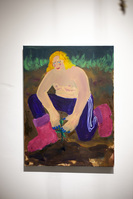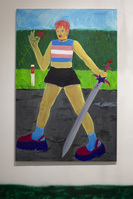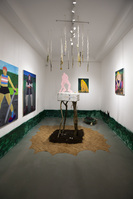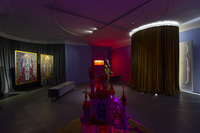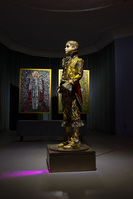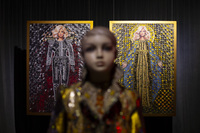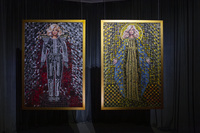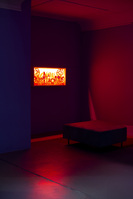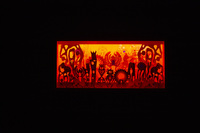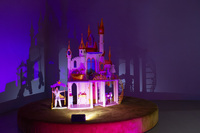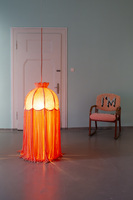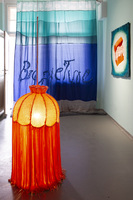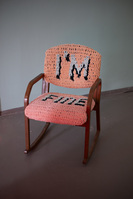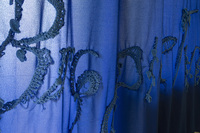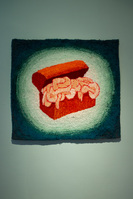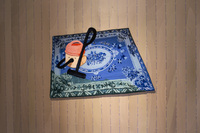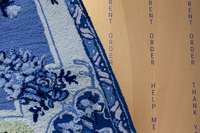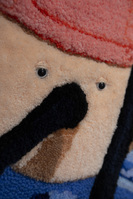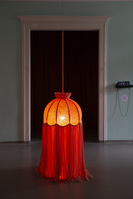In the quasi-domestic space of the exhibition, an attempt is made to reclaim autonomy by creating a utopia of the ideal children's room that reflects real personalities and innermost fantasies.
uszebt - to care, shabti - to respond
Artists who dared to share their intimate world of their youth were invited to take a voyeuristic journey through time and space. Creating their own children's rooms, they have built a life-size dolls' house in the gallery space, where everyone can be a "Grande Pandore" - a life-size doll, playing the role we were not allowed to play growing up, due to various factors: society, family, culture, church or school. In the quasi-domestic space of the exhibition, an attempt is made to reclaim autonomy by creating a utopia of the ideal children's room that reflects real personalities, innermost fantasies, real desires and pains. In this way, by taking care of oneself, the shame that has been burning for years is slowly transformed into pride.
The doll is closely associated with the liminal moment of transition. In ancient Egypt, miniature figures called uszebti (guardians) accompanied the dead in their imagined life after death. In many cultural circles, girls could only own dolls until their nuptials and boys until puberty. For centuries, dolls' houses taught life lessons and were miniature reflections of social orders.
The most magnificent dolls' house was given a hundred years ago as a gift from the British people to Queen Mary Teck, wife of George V, whose life never depended on her own choices. It was the richest miniature palace created in every detail without Mary's involvement. Subordinated all her life to protocol, the queen was a puppet in the hands of a patriarchal dictatorship, and the ideal doll's house seems to be a cruel mockery of her fate.
In the exhibition at the CCA Kronika, Karolina Balcer, Iwona Demko, Adam Łucki and Małgorzata Mycek break stereotypes. They create rooms in which they play with themselves. They design and make each element with their own hands, and the creative process is a reworking and unravelling of imposed social and family patterns.
According to Egyptian legends, the transformation of the uszebti figurines into their actual doubles was ensured by a spell, recorded in the 6th chapter of the Book of the Dead. When the time came for the doll to become its own owner, it spoke the words: "Here I am".
The artists involved in the Dollhouse project sweep the well-hidden from under the carpet, conjuring reality through art into new autonomous stories of self-creation.
Guided tours:
Biographies:
Karolina Balcer - born in 1988 in Toruń. She lives and works in Warsaw. Graduate of the Academy of Fine Arts in Wrocław (2014) and interdepartmental doctoral studies at the same university (2017). Scholarship holder of the Ministry of Culture and National Heritage (2020) and participant of artistic residencies including Kulturkontakt in Vienna (2018). Between 2015 and 2019 she co-founded the Wykwit gallery in Wrocław. The subject matter she takes up often determines the choice of media she uses for her work - these include painting, video, installations in public space and, more recently, tufting (carpet technique) or a broadly defined textile method. Her projects often involve the active participation of family members, are based on private experiences and take an educational form. Between 2020 and 2024, she worked on a family project dealing with mental health issues, which culminated in a series of exhibitions with an accompanying educational programme and the publication "Happy Family - a guide to mental health", published by Krupa Gallery and Bęc Zmiana.
Iwona Demko - visual artist, graduate from the Academy of Fine Arts in Krakow, where she currently works as a university professor. To date, she has participated in over 200 exhibitions at home and abroad. Curator of feminist exhibitions, author of a book about the first female student of the Academy of Fine Arts in Krakow, Zofia Baltarowicz-Dzielińska, initiator and organiser of the 'Year of Women at the Academy of Fine Arts' dedicated to the 100-year presence of women at the Academy of Fine Arts in Krakow. She is interested in the herstory and experiences of women - with a particular focus on women artists - considered through the prism of changing social roles throughout history. For many years, she has been involved in the affirmation of sexuality and female genitalia. Since 2016, one of her activities has been herstorical empathy, based on research on archival material. She creates objects and sewn textile paintings, installations, site-specific works, videos and works in the internet space. Her flagship colour in life and art is pink.
Adam Łucki - born 1983, visual and intermedia artist, stage designer, illustrator. Graduate of the Institute of Visual Arts at the University of Zielona Góra (diploma 2020). Studied Art History at the Faculty of History of the Jagiellonian University in Kraków. He developed his stage design workshop working with Zofia de Inez, Agata Duda Gracz, Jerzy Stuhr, Anna Polony, Krzysztof Jasiński, Józef Opalski, Grzegorz Bral, Robert Czechowski, among others. He has created for theatre, opera and film, producing a total of over 30 set designs. He specialises in illustrating the works of Stanisław Lem. Produces and creates original artistic actions, installations and paratheatrical activities.
Małgorzata Mycek (he/him) - born in Sanok in 1993. Works with painting and performance. He grew up and currently lives and works in a small village in the Bieszczady Mountains. In his artistic work, he explores the theme of the periphery, which is romanticised in mainstream discourse. In addition, his interest in grassroots initiatives, queer, feminism, emancipation strategies and folk history resonates in his projects. He enjoys collective work. In 2020, he received his MFA from the Faculty of Painting and Drawing at the University of Arts in Poznan. He was awarded a distinction in the 46th edition of the Bielska Jesień Biennale, in the 12th edition of the New Image/New Look competition, in the 40th edition of the Maria Dokowicz competition for the best graduation work and in the Allegro Prize 2021 competition. He is a finalist of the 19th edition of the Artistic Journey of Hestia competition. He led the Wydawnictwo Bomba initiative awarded in the competition Young Wolves 19.
- Exhibition
- Concert
- 29 June ‒ 11 October 2024
- curator: Agata Cukierska, Katarzyna Kalina
- artists: Karolina Balcer, Iwona Demko, Adam Łucki, Małgorzata Mycek
- opening: 29.06. (Saturday) from 7:00 pm to 9:30 pm
- during the opening DJ set: PLK (8:00 – 9:30 pm)
- as part of the series "Service"
- matronage: Kampania Przeciw Homofobii, Kolektyw Śląsk Przegięty, Stowarzyszenie BoMiasto
- media matronage: Gazeta Wyborcza, Magazyn Replika, Magazyn Szum, NN6T, Śląska Opinia
- visual identity: Marcin Wysocki
- tickets: 1 PLN (reduced), 3 PLN (regular)
- partnership: Katowice GZM 2029 - kandydat na Europejską Stolicę Kultury
